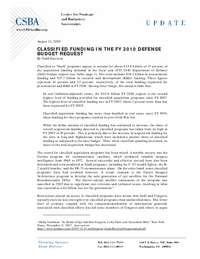
Classified or “black” programs appear to account for about $35.8 billion, or 17 percent, of the acquisition funding included in the fiscal year (FY) 2010 Department of Defense (DoD) budget request (see Table, page 3). This total includes $18.1 billion in procurement funding and $17.7 billion in research and development (R&D) funding. These figures represent 14 percent and 22 percent, respectively, of the total funding requested for procurement and R&D in FY 2010. Among other things, this analysis finds that:
- In real (inflation-adjusted) terms, the $35.8 billion FY 2010 request is the second highest level of funding provided for classified acquisition programs since FY 1987. The highest level of classified funding was in FY 2007, about 1 percent more than has been requested for FY 2009.
- Classified acquisition funding has more than doubled in real terms since FY 1995, when funding for these programs reached its post-Cold War low.
- While the dollar amount of classified funding has continued to increase, the share of overall acquisition funding directed to classified programs has fallen from its high in FY 2003 of 19 percent. This is primarily due to the increase in acquisition funding for the wars in Iraq and Afghanistan, which have included a smaller share of classified funding as compared to the base budget. Thus, while classified spending increased, its share of the total acquisition budget has decreased.
The record for classified acquisition programs has been mixed. A notable success was the Corona program for reconnaissance satellites, which produced valuable imagery intelligence from 1960 to 1972. Several successful and effective aircraft have also been developed and even produced as black programs, including the F-117 stealth fighter, the B- 2 stealth bomber, and the SR-71 reconnaissance plane. On the other hand, some classified programs have had troubled histories. A recent example is the Future Imagery Architecture program to develop the next generation of spy satellites for the National Reconnaissance Office. The electro-optical satellite component of the program was cancelled in 2005 due to significant cost overruns and technical issues, resulting in what was reported as a $4 billion loss for the government.



























